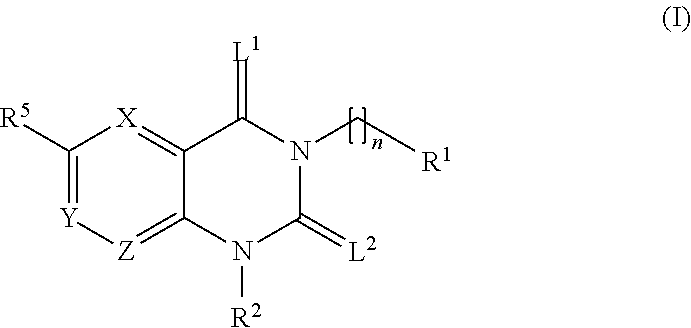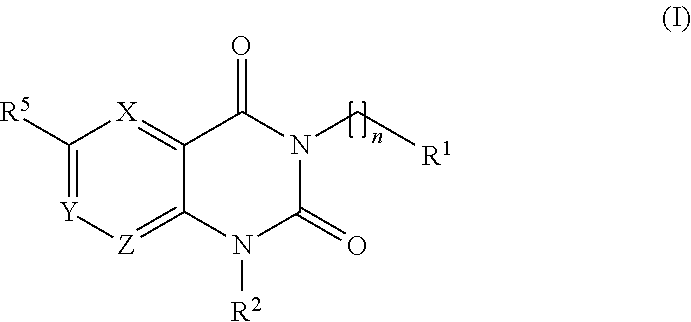Treatment of chagas disease
a technology of chagas disease and chagas disease, which is applied in the field of treatment of chagas disease, can solve the problems of difficult diagnosis of i>t. cruzi /i>infection, congenital transfusion/transplantation transmission becoming increasingly recognized as significant threats, and chagas disease may become a serious health issue, so as to increase the flux of compound across the skin and control the delivery of compound
- Summary
- Abstract
- Description
- Claims
- Application Information
AI Technical Summary
Benefits of technology
Problems solved by technology
Method used
Image
Examples
example 1
[0177]
Step a): N-(2,4-Dioxo-1,4-dihydro-2H-benzo[d][1,3]oxazin-6-yl)-acetamide (1a)
[0178]triphosgene (3.8 g, 1.28 mmol) was added to a solution of 5-acetamido-2-amino-benzoic-acid (5 g, 25.7 mmol) in 1,4-dioxane (100 mL) and the solution was heated at 110° C. for 6 h. The solution was then cooled to room temperature whereafter a saturated aqueous solution of NaHCO3 (20 mL) was added. The mixture was filtered and the filtered solid was washed with water followed by hexanes. The solid was dried at 60° C. under vacuum to afford the title compound as a solid (5 g, 89%).
[0179]1H NMR (DMSO-d6, 400 MHz) δ 11.66 (1H, s), 10.17 (1H, s), 8.24 (1H, d, J=2.4 Hz), 7.80 (1H, dd, J=8.8, 2.4 Hz), 7.10 (1H, d, J=8.8 Hz), 2.04 (3H, s). MS: m / z 221 [M+1]+.
Step b) 5-Acetamido-2-amino-N-(2-(cyclohex-1-en-1-yl)ethyl)benzamide (1b)
[0180]DMAP (0.5 mmol) was added to a solution of cyclohexenyl ethylamine (0.087 g, 0.7 mmol) and the isatoic anhydride 1a (0.1 g, 0.45 mmol) was dissolved in DMF (10 mL) followe...
example 2
[0183]
(R)—N-(3-(1-cyclohexylethyl)-2,4-dioxo-1,2,3,4-tetrahydroquinazolin-6-yl)acetamide (2)
[0184]The isatoic anhydride 1a (0.2 g, 0.9 mmol) and (R)-1-cyclohexylethan-1-amine (0.11 g, 0.9 mmol) were reacted according to the procedure described in Example 1 steps b and c, which gave the title compound (0.1 g, 34%) over two steps.
[0185]1H NMR (DMSO-d6, 400 MHz): δ 11.50-11.10 (1H, br m), 10.08 (1H, s), 8.21 (1H, d, J=2.4 Hz), 7.77-7.75 (1H, m), 7.09 (1H, d, J=8.4 Hz), 4.75-4.55 (1H, m), 2.18-2.09 (1H, m), 2.04 (3H, s), 1.89-1.86 (1H, m), 1.73-1.70 (1H, m), 1.59-1.57 (2H, m), 1.40-1.34 (4H, m), 1.35-1.20 (2H, m), 1.17-1.11 (2H, m), 0.91-0.88 (2H, m). MS: m / z 328 [M−1]−.
example 3
[0186]
N-[3-(2-Cyclohexylethyl)-2,4-dioxo-1,2,3,4-tetrahydroquinazolin-6-yl]acetamide (3)
[0187]Isatoic anhydride 1a (1.0 g, 4.5 mmol) and cyclohexyl ethylamine (0.89 g, 7 mmol) were reacted according to the procedure described in Example 1 steps b and c, which gave the title compound (0.8 g, 54%) over two steps.
[0188]1H NMR (DMSO-d6, 400 MHz): δ 11.35 (1H, s), 10.09 (1H, s), 8.21 (1H, d, J=2 Hz), 7.78 (1H, dd, J=8.8, 2 Hz), 7.11 (1H, d, J=8.8 Hz), 3.92-3.88 (2H, m), 2.04 (3H, s), 1.76-1.72 (3H, m), 1.66-1.64 (3H, m), 1.45-1.42 (2H, m), 1.33-1.23 (3H, m), 1.22-1.18 (2H, m). MS m / z 328 [M−1]−.
PUM
 Login to View More
Login to View More Abstract
Description
Claims
Application Information
 Login to View More
Login to View More - R&D
- Intellectual Property
- Life Sciences
- Materials
- Tech Scout
- Unparalleled Data Quality
- Higher Quality Content
- 60% Fewer Hallucinations
Browse by: Latest US Patents, China's latest patents, Technical Efficacy Thesaurus, Application Domain, Technology Topic, Popular Technical Reports.
© 2025 PatSnap. All rights reserved.Legal|Privacy policy|Modern Slavery Act Transparency Statement|Sitemap|About US| Contact US: help@patsnap.com



